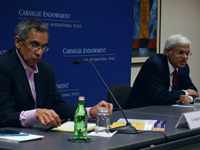Registration
You will receive an email confirming your registration.
IMGXYZ3274IMGZYXThe Pakistani economy has experienced roller-coaster development since Pakistan's formation as a state. Despite an early phase of impressive growth, the country’s economy was unable to realize its potential for improving the lives of millions of Pakistanis, thereby contributing to the repeated crises facing the state today.
Carnegie’s S. Akbar Zaidi explored the core challenges facing the Pakistani economy, its impact on political and social development, and how it might be transformed in ways that help Pakistan become a successful state. Carnegie's Ashley J. Tellis moderated.
Diagnosing the Pakistani Economy’s Ailments
Tellis noted that what happens to the Pakistani economy will determine the long-run path for the country, making Pakistan’s economy a more critical issue than many of the immediate and transient crises plaguing Pakistan. Zaidi examined some of the signs of Pakistan’s economic illness:
- The Statistics: Zaidi noted that Pakistani growth rates over the last sixty years have averaged 5 percent, a respectable rate. Over the last twelve years, per capita income has doubled within the country, and now 65 percent of Pakistanis own a mobile phone even though 40 percent of Pakistanis remain below the poverty line. He added that roughly 55 percent of Pakistan’s population is urban, almost double that of India.
- Comparison with the Neighbors: An alternative metric to measuring Pakistan’s economy, Zaidi said, is comparing it to its neighbors. Almost all of its neighbors have much higher growth rates, and they are all on a much faster trajectory. Indeed, Zaidi concluded, Pakistan only comes out favorably when compared to Afghanistan.
- Potential: Zaidi stated that Pakistan has also fallen short of its potential. In 1965, it was seen as an economic superstar that could rapidly grow to become a model for the rest of the developing world; these predictions have proven wildly optimistic.
- The Fundamentals: The Pakistani economy’s fundamentals, or the traditional bases of economic growth, are showing a sense of crisis, but Zaidi argued that Pakistan’s economy does not actually work on fundamentals. Tellis and Zaidi agreed that one of the key drivers of the economy remains remittances, which is a bottom-up way of injecting capital into the economy. Additionally, Pakistan is actually a very investor-friendly country in terms of regulation and a relative lack of corruption, but the key ingredient for foreign investment – security – is missing.
The Rollercoaster Economy
Zaidi described the Pakistan as having a “rollercoaster” economy – it grows for a few years at 5-7 percent, then slows and ekes out only a few percentage points a year before returning to its previous rate of growth. As a result, Zaidi said, there has not been any long-term, consistent growth. Although there are many reasons for this, he focused on three key aspects:
- The Political Economy of Defense: Zaidi argued that, in addition to defense spending, the omnipresence of the military in the Pakistani state has had several deleterious consequences. While authoritarianism is not inherently bad for economic growth, the army’s control of the state has meant that economic decisions take place in an environment that is contorted by the heavy hand of the military, which makes economic growth uncertain. As an example, economic decisions like which country to buy certain products from are determined primarily by strategic concerns as opposed to economic ones.
- Lack of a Long-Term Social Contract: Zaidi added that the civilian elite must also share in the blame, as they have been unwilling to create an implicit social contract with the Pakistani people. Without a vision or a long-term commitment, there has been no concomitant long-term economic plan. Thus, every change of government has led to new mistakes and new plans, augmenting the rollercoaster nature of Pakistan’s economic growth.
- The Political Economy of Aid: Pakistan has always been an incredibly aid-dependent country, Zaidi said, but once it became a frontline state due to American security concerns, the aid became much more oriented towards unproductive sources like the military. Pakistan has foregone deep-seated infrastructural reform because it knows its nuclear weapons and importance in fighting terrorists guarantee continued Western aid. Furthermore, Zaidi added, the prerequisite for a wide tax base – the Pakistani elites – have refused to allow themselves to be taxed (leading to a tax base that is less than 1 percent of the population) since they know the United States will ultimately foot the bill.
The Future
The recent rise of the media and the judiciary is an important change in Pakistan, Zaidi said, but the military could easily return to power in the near future. Tellis added that since the election of President Zardari, there has been a space created for representative government, which, if negotiated properly, could have momentous consequences.
Zaidi concluded that while tax and aid reform are both incredibly unlikely at the current moment, there is potential for a real reconciliation with India. If this occurred, he said, it would be revolutionary – there is a massive potential for trade between India and Pakistan, and if this were realized, then there would be concurrent massive changes in the political and social economy of the country. In this sense, Zaidi argued that Pakistan’s future lies with New Delhi, not Washington. Both Tellis and Zaidi concluded that the recent effort for Pakistan to grant Most Favored Nation (MFN) status to India could thus be extremely significant, and the beginning of a positive cycle that eases many of the Pakistani economy’s ailments. Whether the MFN deal will go through or not, though, remains questionable.
